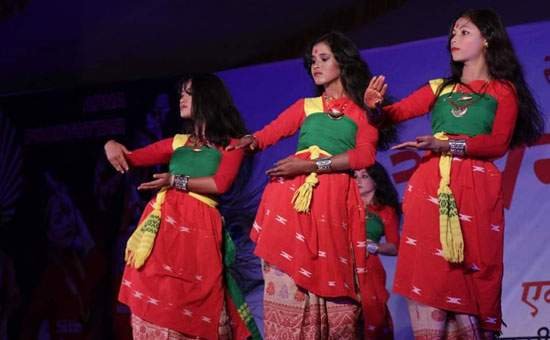Assam, nestled in the northeastern corner of India, boasts a cultural heritage as diverse and vibrant as its picturesque landscapes.
Cultural Heritage of Assam
From ancient rituals and traditional art forms to modern expressions of creativity, Assam’s cultural tapestry reflects the rich history, ethnic diversity, and spiritual depth of the region. This news report embarks on a journey through the cultural heritage of Assam, uncovering its myriad facets and celebrating its timeless legacy.
Ancient Roots: The Legacy of Assamese Civilization
Assam’s cultural heritage has deep roots that stretch back thousands of years, with evidence of human habitation dating back to the Stone Age. The region’s ancient history is marked by the flourishing of early civilizations, including the ancient kingdom of Kamarupa, which played a pivotal role in shaping Assamese culture and identity.
Temples and Monuments
One of the most enduring symbols of Assam’s ancient civilization is the Kamakhya Temple, dedicated to the goddess Kamakhya. Perched atop Nilachal Hill in Guwahati, this revered shrine attracts pilgrims and devotees from far and wide, making it a center of spiritual and cultural significance. Other ancient temples, such as the Sivasagar Sivadol and the Madan Kamdev Temple, stand as testaments to Assam’s rich architectural heritage.
Ahom Legacy
The Ahom dynasty, which ruled Assam for over six centuries, left an indelible mark on the region’s cultural landscape. The Ahoms, of Tai-Ahom ethnicity, introduced distinct architectural styles, language, and social customs that continue to influence Assamese culture to this day. Majestic monuments like the Rang Ghar (Amphitheater) and Talatal Ghar (Palace) stand as reminders of the Ahom legacy, showcasing their architectural prowess and administrative sophistication.
Festivals and Rituals: Celebrating Life’s Rhythms
Assam’s cultural calendar is marked by a colorful array of festivals and rituals, each steeped in tradition and symbolism. These celebrations offer glimpses into the religious beliefs, agrarian practices, and social customs of the diverse communities that call Assam home.
Bihu: The Festival of Life
Bihu, the most important festival of Assam, celebrates the changing seasons and the cycle of agricultural life. Held thrice a year—Rongali Bihu (spring), Kongali Bihu (autumn), and Bhogali Bihu (harvest)—Bihu is marked by lively music, vibrant dances, and traditional rituals. The sound of the dhol (drum), the rhythms of the pepa (buffalo horn), and the graceful movements of the Bihu dancers create an atmosphere of joy and camaraderie that transcends linguistic and cultural boundaries.
Durga Puja: The Triumph of Good over Evil
Durga Puja, celebrated with great fervor across Assam, honors the goddess Durga and her victory over the demon Mahishasura. Elaborate pandals (temporary structures) adorned with intricate decorations, colorful idols of Durga and her retinue, and the fragrance of incense fill the air during this auspicious festival. Durga Puja is not just a religious event but also a cultural extravaganza, showcasing Assam’s artistic talents and community spirit.
Ali-Aye-Ligang: The Festival of the Mising Tribe
Ali-Aye-Ligang, celebrated by the Mising tribe of Assam, is a festival that heralds the arrival of spring and the beginning of the agricultural season. Traditionally observed with rituals invoking the blessings of the gods for a bountiful harvest, Ali-Aye-Ligang is characterized by music, dance, and feasting. The rhythmic beats of the drum, the swirling movements of the dancers, and the joyful laughter of children create an atmosphere of merriment and togetherness.
Traditional Arts and Crafts: Preserving Heritage
Assam is renowned for its rich tradition of arts and crafts, which have been passed down through generations. From handloom weaving and pottery to mask-making and bamboo crafts, Assamese artisans continue to practice ancient techniques and create exquisite works of art that reflect the region’s cultural heritage.
Assam Silk: A Symbol of Elegance
Assam is famous for its silk weaving tradition, particularly the production of Muga silk, Eri silk, and Pat silk. Muga silk, known for its natural golden hue, is considered one of the finest varieties of silk in the world. The intricate designs and motifs woven into Assamese silk fabrics, such as the traditional Assam motifs of jaapi (hat), xoraai (elephant), and gos (tree), showcase the craftsmanship and aesthetic sensibility of Assamese weavers.
Jaapi: The Traditional Assamese Hat
The jaapi, a traditional conical hat made from bamboo and palm leaves, is an iconic symbol of Assamese culture. Jaapis are intricately woven by skilled artisans using
The cultural heritage of Assam is a rich tapestry woven from threads of tradition, diversity, and resilience. From ancient rituals and architectural marvels to vibrant festivals and exquisite crafts, Assam’s cultural landscape is a testament to the enduring spirit of its people.
As we traverse the ancient temples of Kamakhya and the majestic monuments of the Ahom dynasty, as we dance to the rhythmic beats of the Bihu drums and marvel at the intricate designs of Assamese silk, we are reminded of the timeless beauty and depth of Assamese culture.
In a rapidly changing world, it is more important than ever to cherish and preserve the cultural heritage that binds communities together and nurtures a sense of belonging and identity. Through initiatives that promote cultural exchange, artistic expression, and intergenerational dialogue, we can ensure that the legacy of Assamese culture continues to thrive and inspire generations to come.
As we celebrate the vibrant mosaic of Assam’s cultural heritage, let us embrace the diversity that enriches our lives and strengthens our bonds as a global community. In the words of Rabindranath Tagore, “The highest education is that which does not merely give us information but makes our life in harmony with all existence.” Let us strive to live in harmony with the rich tapestry of Assamese culture, honoring its past, embracing its present, and nurturing its future.
ALSO READ: ALLEGED EXTORTION BY BIR LACHIT SENA YOUTHS SPARKS INVESTIGATION IN GUWAHATI











